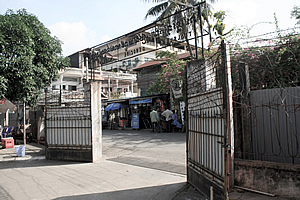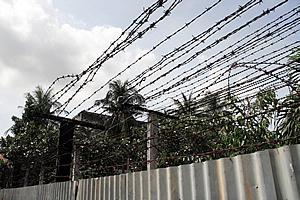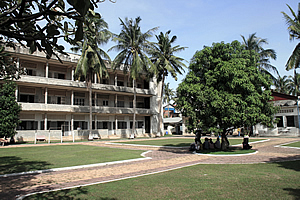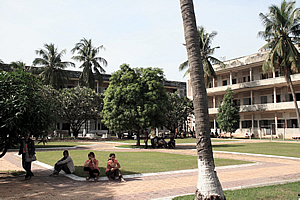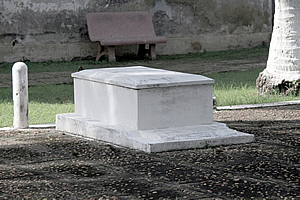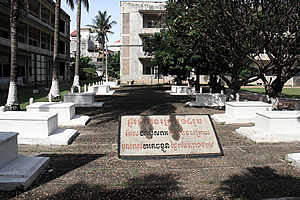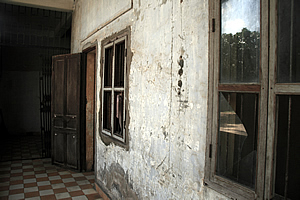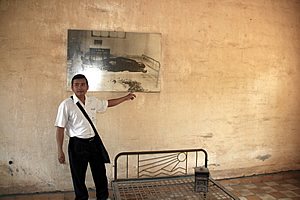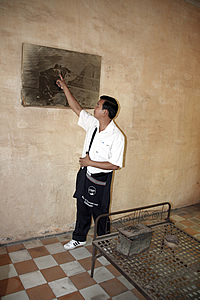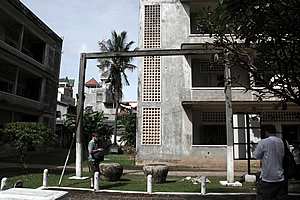--- Archive files ---
Home > Travels > Phnom Penh > 2 |
School of Torture
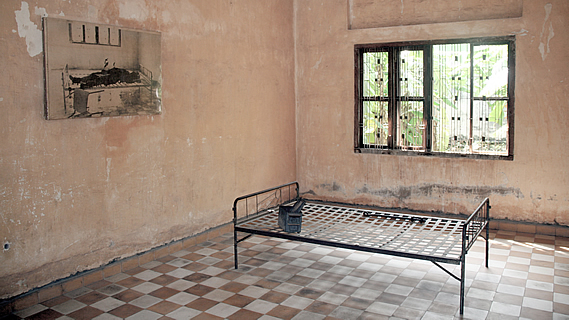
WE WERE still within the southern outskirts of Phnom Penh when the van we were travelling in pulled up outside a high fence with tight coils of barbed wire on top. It definitely wasn’t the sort of fence you would want to attempt to climb. I already felt an eerie presence here. We had arrived at the notoriously infamous Tuol Sleng genocide museum. I really wasn’t sure what to expect - perhaps a stuffy museum with displays of torture implements.
Looking out of the entrance to Tuol Sleng |
Outside the van stood a mildly overweight dark skinned Cambodian man who I thought was exceptionally well scrubbed up for a tour guide. He was immaculately dressed in a white shirt, black trousers, a black bag with a long shoulder strap and brand new white running shoes that didn’t have as much as a grain of dust on them. His perfectly ironed shirt more than accentuated the darkness of his deeply brazen face. His hair was flawlessly styled and perfectly parted. He broke a distant smile in acknowledgement of our arrival as we left the van and greeted him before we followed him into the museum. His name was Ponleak.
Barbed wire fence top |
We passed through a wide open double gate with coiled barbed wire running along the top. It was stifling hot and humid out here despite it still being early morning. A large white board stood in front of us with a poorly maintained pale green roof and a small white flourish at either end vaguely resembling those I had seen on the palace and national museum near the hotel. The board had writing in three languages – The local Khmer language on the left hand side, French in the middle, and English on the right.
Tuol Sleng |
Had it not been for the incredibly eerie presence here, I would have found this board rather amusing for its poor grammar and punctuation.
The eerie atmosphere here was so grave that the acknowledgement of any humour seemed totally out of place. Here in this school previously attended by innocent children, over seventeen thousand people had been imprisoned before their executions.
The earlier prisoners were tortured and executed here, but when they ran out of places to bury the dead on the school grounds, they were taken to the Choeung Ek extermination centre for execution upon completion of the interrogation and torture processes.
Initially the prisoners were workers of the previous government including government officials, soldiers, academics, doctors, teachers, students, engineers, factory workers and monks. Towards the end of the regime most of the prisoners were rebels and their families who the leaders of the Pol Pot regime suspected were going to form a coup.
Ponleak led us to the left of the board and entered a large courtyard. The courtyard was mostly paved, with large squares of well-maintained bright green grass in a patchwork between the three storey blocks of classrooms surrounding it. Each level of classroom had a narrow balcony out the front. Tall coconut palms and large bushy broadleaf trees grew in rectangular grass patches around the courtyard squares.
Tuol Sleng |
There were a few motorbikes parked inside the entrance and about thirty local Cambodian people were sitting around, seemingly with nothing to do. There were three gorgeous girls wearing peach coloured shirts sitting just a few metres of us at the edge of the paving exposed to the hot sun. Further away, every shady tree had some locals sitting under it quietly. There was not the happy chatter you would expect anywhere else, but they seemed very solemn. Perhaps they were resting on break, or maybe they were waiting for unguided tourists so they could show them around to earn a few meagre dollars to feed their families. Either way I wondered how they could possibly sit there so relaxed whilst immersed in such an eerie atmosphere.
Ponleak mentioned in a slightly high pitched monotone that this used to be a secondary school built in the 1950s. He told us that this was formerly the Chao Ponhea Yat High School, named after a royal ancestor of King Sihanouk, who was ruling at the time.
Grave |
In 1975 when the king had been exiled into China, the Khmer Rouge under Pol Pot suddenly evacuated Phnom Penh, telling the people that the Americans were coming to bomb the city and they would have to evacuate it for three days. Three days came and went, and no bombing occurred, but the people were not allowed back into the abandoned city. Only some of the soldiers under Pol Pot remained.
They took over the school and turned it into a torture prison for those who dared to rebel against the new regime. The windows were barred and the school was surrounded with electrified barbed wire fencing.
It was renamed Tuol Sleng - Hill of the Poisonous Trees.
Graves |
We walked towards the classrooms to the left of the entrance, stopping at some large white graves a few metres short of the building. All the inscriptions were written in Khmer, but our guide explained these graves contained the bodies discovered here when Pol Pot’s regime had been overthrown. Each tomb was a rectangular white washed concrete sarcophagus sitting on the ground. No doubt each had one or more bodies in it.
Ponleak led us into the first of the classrooms. Inside it was bare, with no furnishings apart from a rusting metal bed in the middle of the room. The bed was quite wide and had a chequered strap system to hold the mattress, which was missing. The walls had been painted a ghastly orange brown, though large areas of the paint had eroding off showing the swirls in which it had been applied some four or five decades ago. The floor was tiled with a chequered pattern of white and dark brown tiles which were rather worn, but otherwise very clean.
Graves |
There was a small box on the bed containing the straps and shackles used to tie the prisoner to the bed.
Above the bed was a picture, innocuously providing the only decoration in the room. The picture was a morbid enlarged photograph of the decomposing body of the last prisoner left here when the school was abandoned when the Pol Pot regime was overthrown. The man’s body was emaciated, bearded from his long internment, and fully clothed. He was lying on his back with the skeletal left hand up next to the shrivelled remains of his face with his mouth agape. He was turned across to one side.
I imagined when the photo was taken the smell in the room must have been unbelievably nauseous in this tropical heat. In the photo there was a large stain on the floor where decomposing body fluids had oozed out of his wounds and splattered. On the real floor there was still some black staining on the floor from where the pool of blood had etched its way through the enamel of the low grade tiles.
Near the door we had entered was the rusting frame of a chair used by the interrogators. The prisoners were tied to the chair and tortured into a confession. If they didn’t confess they had worked for the government, they were executed. If they did admit it, they were executed. There was no way out of here. There were many similar torture centres like this, and Cambodia lost much of its talent through three million of its people being killed.
Most of the guards were teenagers. They struggled with the very strict rules here, where they were not allowed to talk to prisoners. Observing or eavesdropping on the interrogations was forbidden as was beating the prisoners. They were ordered to walk the compound, guard and examine everything carefully. Serious breaches of the rules resulted in interrogation and execution. Most people employed here were constantly terrified of making mistakes in the fear they would be tortured and executed.
The interrogators were split into three groups. The chewing unit dealt with tough and important cases. Otherwise all prisoners would be interrogated by the “cold” unit who were not allowed to use torture. If the cold unit couldn’t get a confession out of the prisoner, then the “hot” unit was brought in. The hot unit were allowed to use any method of torture to assist in getting the confession out of them. Most interrogators were aged in their twenties.
Ponleak discusses the body discovered in this room when the prison was abandoned |
We left the morbid classroom and walked along the outdoor corridor to the next one. This classroom was the same with a bed in the middle of the room and a worn photo above it. This corpse had been slumped on the floor, lying on his back next to the bed. Again he was fully clothed in several layers of clothing, perhaps excessive in this hot climate.
We entered a third classroom. It was exactly the same. Orange terracotta walls, white and terracotta tiles on the floor, a bed and a chair. Both bed and chair were uncovered and rusting. A photo hung above the bed showing another dead man lying face up on the bed. The windows were barred. Ponleak told us that of the many thousands of people sent here to be killed, only seven people survived.
They only survived because they were lucky enough to have been here right at the end when the Khmer Rouge were overtaken during an invasion by the Vietnamese. Three of them were still alive today. All three had since testified that they had been kept alive only because they had skills useful to the captors. One was an artist whose wife had been killed in the prison. Another was kept alive due to his skills in machinery repairs, and the other had managed to get a transfer due to distinguishing herself by emphasising her provincial accent during her interrogations.
Ponleak discusses the body discovered in this room when the prison was abandoned |
Most of the guards were teenagers. They struggled with the very strict rules here, where they were not allowed to talk to prisoners. Observing or eavesdropping on the interrogations was forbidden as was beating the prisoners. They were ordered to walk, guard and examine everything carefully. Serious breaches of the rules resulted in interrogation and execution. Most people employed here were constantly terrified of making mistakes in the fear they would be tortured and executed.
We left the block of classrooms. There were more of the same in that block, and more upstairs in the two levels above, but we didn’t enter them. Those classrooms were boarded up to keep us out and to leave the tortured souls to fester in peace. Outside the classroom was another board. This one didn’t have a roof over it, but again it was in three languages. This one read:
THE SECURITY OF REGULATION
- You must answer accordingly to my questions – Don’t turn them away.
- Don’t try to hide the facts by making pretexts this and that. You are strictly prohibited to contest me.
- Don’t be a fool for you are a chap who dare to thwart the revolution.
- You must immediately answer my questions without wasting time to reflect.
- Don’t tell me either about your immoralities or the essence of the revolution.
- While getting lashes or electrification you must not cry at all.
- Do nothing, sit still and wait for my orders. If there is no order, keep quiet. When I ask you to do something, you must do it right away without protesting.
- Don’t make pretext about Kampuchea Kromin order to hide your secret or traitor.
- If you don’t follow all the above rules, you shall get many lashes of electric wire.
- If you disobey any point of my regulations you shall get ten lashes or five shocks of electric discharge.
Gallows |
We walked past the graves, and saw a large wooden frame standing some five metres high that had been used to hang prisoners once the interrogators had either gotten a confession out of them or had otherwise decided they were dishonest. Next to the wooden frame was a set of three climbing bars elevated at different heights for children to play on. A chill went down my spine as these were exactly like the bars we had in the schools I had gone to in New Zealand. These bars that innocent children played on in the early 1970s still stood here next to the frame where prisoners were executed just weeks after the school had closed. Decades of decay exacerbated this most confronting juxtaposition.
<< Previous | Next >> |
|
||
About this Page
|
||
|
|
|
Where is Walkabout Jeff? |
|
|
|
|
What is happening in Walkabout Jeff's hometown?
|
|
|
|
|
Who is Walkabout Jeff?Any normal person's idea of going out involves going to the local pub for a drink with a few mates. Walkabout Jeff isn't normal.
|
|
|
|
|
